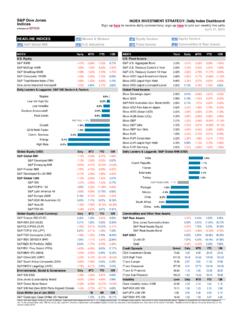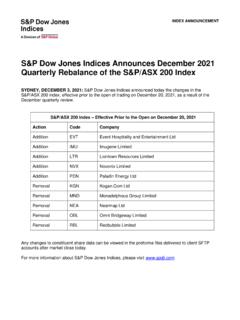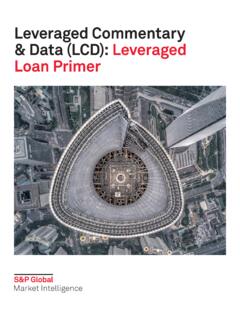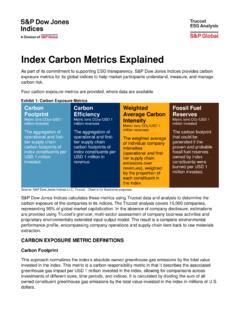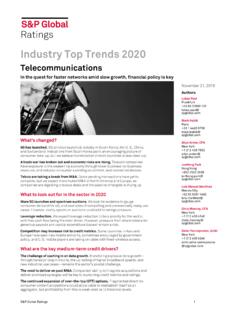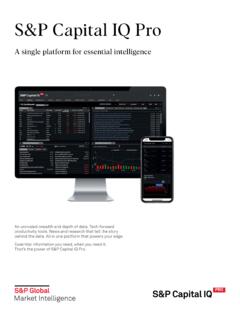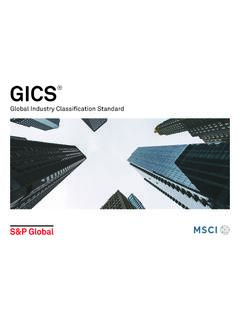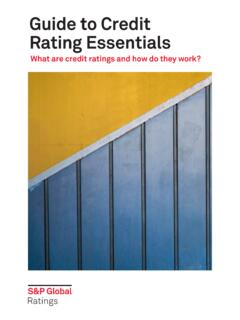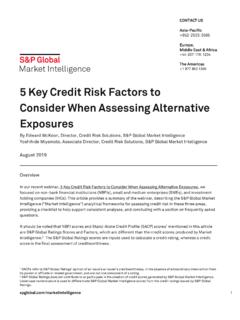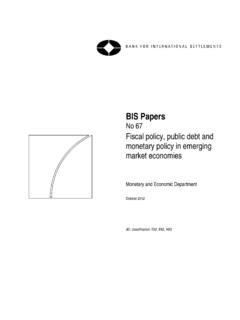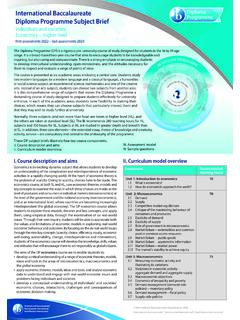Transcription of 20 22 Outlook
1 Global Credit Outlook 2022 Aftershocks, Future Shocks, And Transitions Outlook 2022 2 Foreword 3 Global Credit Outlook 13 Global Economic Outlook 19 Top Global Risks Questions That Matter Aftershocks 20 COVID-19 | Pandemic To Endemic? 22 Inflation | Is It Really Transitory? 24 Rates | Will Tapering And Tightening Trouble Credit Markets? 26 Defaults | Can Corporate Defaults Stay Low? 28 China | Can Risks From Beijing's policy Tightening Be Contained? 30 Corporates | Will Supply Shortages And Surging Costs Sink Margins? 32 Energy | Are High Prices Here To Stay? 33 Emerging Markets | Will Inflation Be The Next Pandemic? 35 Real Estate | Is A Reckoning On The Doorstep? 37 Sovereigns | Can The Books Be Balanced Without Toppling Growth? 39 Banks | Have Lessons Been Learnt? 41 Jobs | Will The "Big Quit" Transform The Labor Market?
2 Future Shocks 43 Global Debt Leverage | Has Soaring Debt Sown The Seeds Of Crisis? 45 China | How Will The Government Address The Corporate Debt Trap? 47 Digitalization | Will DeFi Destabilize Finance? 49 Cyber | Are Credit Markets Ready For A Systemwide Attack? 51 Crypto Assets | Evolution Or Revolution? Climate and Energy Transition 53 Climate Risks | How Far Will They Affect Credit? 55 Energy Transition | How Will Climate Policies Speed Up Change? 57 Nature Risks | At What Price? Regional Credit Conditions 59 Asia-Pacific | China Slows, A Chill Wind Blows 61 Emerging Markets | Inflation, The Unwelcome Guest 63 Europe | Reining In As Full Recovery Nears 65 North America | As Recovery Rolls On, Inflation Risks Remain Global Credit Outlook 2022: Aftershocks, Future Shocks, And Transitions S&P Global Ratings December 1, 2021 2 This report does not constitute a rating action Global Credit Outlook 2022 Foreword Dear reader, In this report, we present our macroeconomic and credit Outlook for 2022, with our base-case forecasts, assumptions, and key risks in what remains a highly uncertain and challenging environment.
3 We provide this Outlook at global and regional levels, reflecting conclusions from our fourth-quarter credit conditions committees involving our senior credit analysts, research teams, and economists. If 2021 was the year of the big rebound, with COVID-19 vaccines fueling a robust economic recovery and steadily improving credit markets, the recent emergence of the omicron variant has offered a stark reminder that we have not yet beaten the virus. More than COVID, persistently high inflation, fueled by supply-chain disruption and soaring energy prices, could be the primary setback derailing a still fragile recovery in 2022. While the credit momentum remains largely favorable, a sharp tightening in financing conditions, triggered by a central bank policy mistake or event risk, could put under pressure the large cohort of riskier credits and some emerging markets. With the pandemic having pushed global leverage to new highs, it is hard to ignore that over 30% of speculative-grade nonfinancial corporate are rated 'B-' and below.
4 Our outlooks consider three categories of challenges and opportunities likely to shape credit markets as we approach a third year living with the pandemic. Aftershocks assesses the immediate pressures largely brought about by the pandemic. Future Shocks focuses on more structural factors and emerging technologies shaping the future of finance. Climate and Energy Transition discusses the credit implications of the behavioral and technical shifts stemming from efforts to avert the most severe consequences of climate change. Within these categories, we also aim to provide you with our answers to 20 Questions That Matter, collected through our interactions with investors and other market participants. Best wishes for a happy holiday season and for the year ahead, Alexandra Dimitrijevic Managing Director Global Head of Analytical Research & Development S&P Global Ratings London Acknowledgments I would like to thank the many colleagues who have contributed to this report to provide you with S&P Global Ratings' essential insights.
5 Special thanks to Gareth Williams, Alexandra Krief, Jennie Brookman, Rose Marie Burke, Cathy Holcombe, Jasper Moiseiwitsch, Bernadette Stroeder and Dana Tong. Global Credit Outlook 2022: Aftershocks, Future Shocks, And Transitions S&P Global Ratings December 1, 2021 3 Global Credit Outlook : Aftershocks, Future Shocks, And Transitions December 1, 2021 Key Takeaways Improving, but still vulnerable credit markets. We enter 2022 with largely positive credit momentum, reflecting favorable financing conditions and a powerful economic recovery. This could be derailed if persistently high inflation pushes central banks to aggressively tighten monetary policy , triggering significant market volatility and repricing risks. New COVID-19 variants could also undermine confidence and recovery prospects. The weakest areas of credit markets--often still highly sensitive to the ongoing impact of the pandemic--are most exposed, particularly highly leveraged corporates and some emerging markets.
6 Fewer downgrades and low default rates. Robust economic growth and largely favorable funding conditions point to a steady overall ratings performance in 2022 with fewer downgrades (6% global net negative bias) and low default rates (around ). Yet persistent supply chain disruptions and high input costs could weigh on growth and ratchet up the pressure on so-far resilient corporate margins. Inflationary pressures are clouding the Outlook for EMs still battling with the pandemic. Leverage continues to build up in the riskiest parts of the credit markets, leaving them exposed to shifts in market sentiment, as illustrated by the recent developments affecting the Chinese real estate developers. Risk of aftershocks from inflation and high global debt. The aftershocks of the COVID-19 pandemic pose significant risks. Persistent inflation, tied to supply chain disruptions and soaring energy prices, could trigger wage inflation and push major central banks, the Fed in particular, to hike rates sooner and faster.
7 This could generate market volatility, likely amplified by elevated global debt levels. New variants could weaken the global economic recovery, as could China s policy and economic developments. Beyond COVID-19, credit markets face significant longer-term uncertainties around energy transition, cyber risk, and evolving financial systems in an increasingly digital economy. The pandemic and its aftershocks will remain pivotal to credit prospects in 2022. Surging global demand, extraordinarily benign financing conditions, supply chain strains, and soaring energy prices are just some examples of the powerful forces triggered by the shock of COVID-19 and the emergency policy response it required. In our view, credit momentum will remain positive, with financing conditions still heavily underwritten by supportive fiscal and monetary policy , and economic growth easing back to a more sustainable pace.
8 Nevertheless, the recovery s foundations are relatively fragile and vulnerable to setbacks. The pandemic itself remains very much active, with the omicron variant posing a new threat and vaccination rates worryingly low in many parts of the world. Our base case is that default rates will remain low and credit prospects continue to show improvement, but uncertainties abound and risk premiums are uncomfortably low. We consider three sets of challenges and opportunities likely to shape the year ahead: Aftershocks assesses the immediate pressures largely brought about by the pandemic; Future Shocks focuses on more structural factors and emerging technologies shaping the future of finance; and Climate And Energy Transition discusses the credit implications of the behavioral and technical shifts stemming from efforts to avert the most severe consequences of climate change. Aftershocks COVID-19 s economic impact has waned but variants are a concern.
9 As we enter the third year of the pandemic, it is difficult to say with certainty that this will be its last. Successful vaccination programs and the ramping up of their global vaccine supply offer the clearest route out and the Alexandra Dimitrijevic London @ +44-20-7176-3128 Gareth Williams London @ +44-20-7176-7226 Jose Perez Gorozpe Madrid +34-91-423-3212 Global Credit Outlook 2022: Aftershocks, Future Shocks, And Transitions S&P Global Ratings December 1, 2021 4 transition from a pandemic to an endemic but manageable disease. Yet ,sharply escalating case counts in heavily vaccinated European nations and the threat that omicron or other variants might overcome existing vaccines are reminders of how far we remain from a post COVID-19 world. Encouragingly, economies are proving adaptable and, particularly when vaccination rates are high, capable of recovering strongly.
10 We forecast global real GDP will grow by in 2022 (from in 2021), but the pace of recovery is uneven globally and highly correlated with vaccination rates and the magnitude of stimulus. Even in countries where life has returned largely to normal, structural changes to consumer behavior, travel, commercial property, and even the desire to work remain apparent. Pandemic-related credit risk may have eased, but it has not been removed. We expect inflation pressures to moderate sufficiently to avoid aggressive monetary tightening. Headline inflation has exceeded most economists expectations in 2021, raising the specter of an abrupt transition in financing conditions should the most influential central banks need to move more quickly to raise interest rates. Major central banks, including the Federal Reserve and the European Central Bank take the view that the surge in inflation primarily reflects pandemic-related distortions that will fade and note that long-term inflation expectations remain well anchored.
